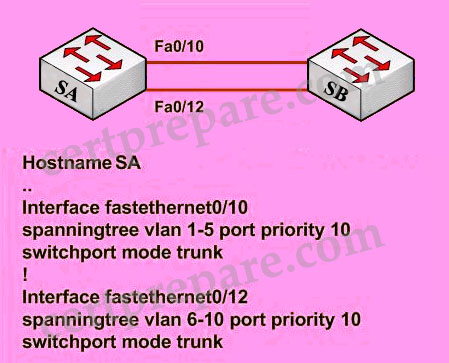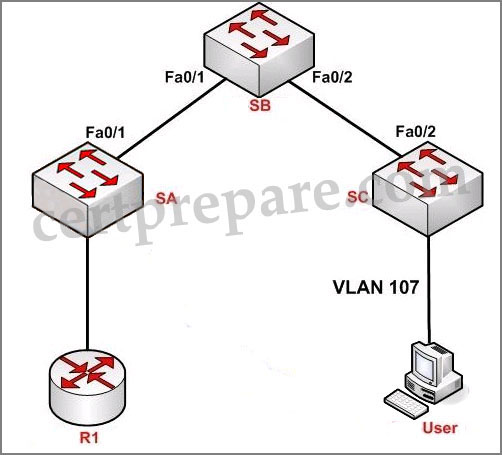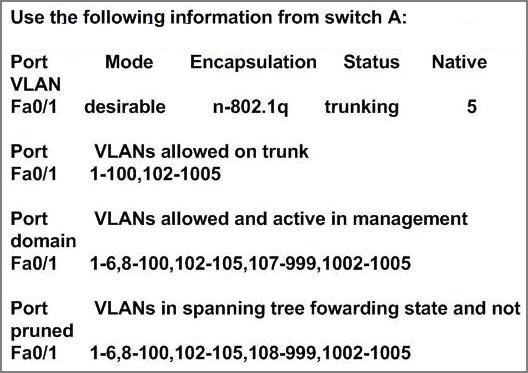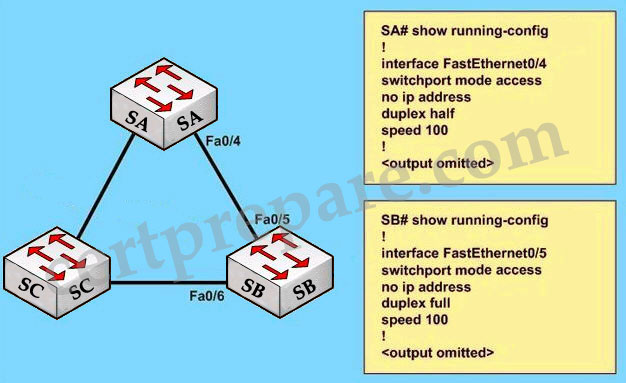Here you will find answers to VLAN, VTP, STP questions
Question 1:
Two switches SA and SB are connected as shown below. Given the below partial configuration, which two statements are true about VLAN traffic? (Choose two)
 A – VLANs 1-5 will be blocked if fa0/10 goes down.
A – VLANs 1-5 will be blocked if fa0/10 goes down.
B – VLANs 6-10 have a port priority of 128 on fa0/10.
C – VLANs 6-10 will use fa0/10 as a backup only.
D – VLANs 1-10 are configured to load share between fa0/10 and fa0/12.
Answer: C D
Explanation:
Let’s assume that SA is the root bridge for all VLANs, it will make the explanation a bit clearer…
First we should understand what will happen if nothing is configured (use default values). Because we assumed that SA is the root bridge so all of its ports will forward. SB will need to block one of its ports to avoid a bridging loop between the two switches. But how does SB select its blocked port? Well, the answer is based on the BPDUs it receives from SA. A BPDU is superior than another if it has:
1. A lower Root Bridge ID
2. A lower path cost to the Root
3. A lower Sending Bridge ID
4. A lower Sending Port ID
These four parameters are examined in order. In this specific case, all the BPDUs sent by SA have the same Root Bridge ID, the same path cost to the Root and the same Sending Bridge ID. The only parameter left to select the best one is the Sending Port ID (Port ID = port priority + port index). If using default values, the default port priority’s value is 32 or 128 (128 is much more popular today but 32 is also a default port priority’s value), so SB will compare port index values, which are unique to each port on the switch, and because Fa0/12 is inferior to Fa0/10, SB will select the port connected with Fa0/10 (of SA) as its root port and block the other port.

Answer D is correct because this configuration provide load-balance traffic based on VLAN basis. VLANs 1-5 use Fa0/10 and VLANs 6-10 use Fa0/12 as their main paths.
Note: We can not assure the answer B is always correct so we should choose C and D if the question asks us to give only 2 choices).
Reference (and good resource, too):
Question 2:
The network operations center has received a call stating that Users in VLAN 107 are unable to access resources through R1. From the information contained in the graphic, what is the cause of this problem?

 A – spanning tree is not enabled on VLAN 107
A – spanning tree is not enabled on VLAN 107
B – VTP is pruning VLAN 107
C – VLAN 107 does not exist on switch SA
D – VLAN 107 is not configured on the trunk
Answer: B
Explanation:
“VLAN allowed on trunk” – Each trunk allows all VLANs by default. However, administrator can remove or add to the list by using the “switchport trunk allowed” command.
“VLANs allowed and active in management” – To be active, a VLAN must be in this list.
“VLANs in spanning tree forwarding state and not pruned” – This list is a subset of the “allowed and active” list but with any VTP-pruned VLANs removed.
All VLANs were configured except VLAN 101 so D is not correct. VLAN 107 exists in the “allowed and active” section so A and C are not correct, too. In the “forwarding state and not pruned” we don’t see VLAN 107 so the administrator had wrongly configured this VLAN as pruned.
Question 3:
The network administrator needs to enable VTP pruning within the network. What action should a network administrator take to enable VTP pruning on an entire management domain?
A – enable VTP pruning on every switch in the domain
B – enable VTP pruning on any client switch in the domain
C – enable VTP pruning on any switch in the management domain
D – enable VTP pruning on a VTP server in the management domain
Answer: D
Question 4:
Study the diagram below carefully, which three statements are true? (Choose three)

 A – DTP packets are sent from Switch SB.
A – DTP packets are sent from Switch SB.
B – DTP is not running on Switch SA.
C – A trunk link will be formed.
D – The native VLAN for Switch SB is VLAN 1.
Answer: A C D
Explanation:
Dynamic Trunking Protocol (DTP) is the Cisco-proprietary that actively attempts to negotiate a trunk link between two switches. If an interface is set to switchport mode dynamic desirable, it will actively attempt to convert the link into trunking mode. If the peer port is configured as switchport mode trunk, dynamic desirable, or dynamic auto mode, trunking is negotiated successfully -> C is correct.
SB is in “dynamic desirable” mode so it will send DTP packets to SA to negotiate a trunk link -> A is correct.
On an 802.1Q trunk, DTP packets are sent on the native VLAN. By default, it is VLAN 1 (notice that SA’s native VLAN is 5) -> D is correct.
(Note: an 802.1Q trunk’s native VLAN is the only VLAN that has untagged frames)
Below is the switchport modes for easy reference:
Mode Function Dynamic Auto Creates the trunk based on the DTP request from the neighboring switch. Dynamic Desirable Communicates to the neighboring switch via DTP that the interface would like
to become a trunk if the neighboring switch interface is able to become a trunk. Trunk Automatically enables trunking regardless of the state of the neighboring switch
and regardless of any DTP requests sent from the neighboring switch. Access Trunking is not allowed on this port regardless of the state of the neighboring
switch interface and regardless of any DTP requests sent from the neighboring
switch. Nonegotiate Prevents the interface from generating DTP frames. This command can be
used only when the interface switchport mode is access or trunk. You must
manually configure the neighboring interface as a trunk interface to establish a
trunk link.
Question 5:
Regarding the exhibit and the partial configuration of switch SA and SB. STP is configured on all switches in the network. SB receives this error message on the console port:
00:06:34: %CDP-4-DUPLEX_MISMATCH: duplex mismatch discovered on FastEthernet0/5 (not half duplex), with SA FastEthernet0/4 (half duplex), with TBA05071417(Cat6K-B) 0/4 (half duplex).
What would be the possible outcome of the problem?
 A – The root port on switch ***-SB will fall back to full-duplex mode.
A – The root port on switch ***-SB will fall back to full-duplex mode.
B – The interfaces between switches ***-SA and ***-SB will transition to a blocking state.
C – The root port on switch ***-SA will automatically transition to full-duplex mode.
D – Interface Fa0/6 on switch SB will transit to a forwarding state and create a bridging loop.
Answer: D
Explanation:
From the output, we learned that the interfaces on two switches are operating in different duplex modes: Fa0/4 of SA in half-duplex mode & Fa0/5 of SB in full-duplex mode. In this case, because SB is operating in full duplex mode, it does not check the carrier sense before sending frames (CSMA/CD is not used in full-duplex mode). Therefore, SB can start to send frames even if SA is using the link and a collision will occur. The result of this is SA will wait a random time before attempting to transmit another frame. If B sends enough frames to A to make every frame sent from A (which includes the BPDUs) get dropped then SB can think it has lost root bridge (B does not receive BPDUs from A anymore). Therefore SB will unblock its Fa0/6 interface for transmitting and cause a bridging loop.
Question 1:
Two switches SA and SB are connected as shown below. Given the below partial configuration, which two statements are true about VLAN traffic? (Choose two)

B – VLANs 6-10 have a port priority of 128 on fa0/10.
C – VLANs 6-10 will use fa0/10 as a backup only.
D – VLANs 1-10 are configured to load share between fa0/10 and fa0/12.
Answer: C D
Explanation:
Let’s assume that SA is the root bridge for all VLANs, it will make the explanation a bit clearer…
First we should understand what will happen if nothing is configured (use default values). Because we assumed that SA is the root bridge so all of its ports will forward. SB will need to block one of its ports to avoid a bridging loop between the two switches. But how does SB select its blocked port? Well, the answer is based on the BPDUs it receives from SA. A BPDU is superior than another if it has:
1. A lower Root Bridge ID
2. A lower path cost to the Root
3. A lower Sending Bridge ID
4. A lower Sending Port ID
These four parameters are examined in order. In this specific case, all the BPDUs sent by SA have the same Root Bridge ID, the same path cost to the Root and the same Sending Bridge ID. The only parameter left to select the best one is the Sending Port ID (Port ID = port priority + port index). If using default values, the default port priority’s value is 32 or 128 (128 is much more popular today but 32 is also a default port priority’s value), so SB will compare port index values, which are unique to each port on the switch, and because Fa0/12 is inferior to Fa0/10, SB will select the port connected with Fa0/10 (of SA) as its root port and block the other port.

To change the default decision of selecting root port, we can change the port priority of each interface. The above picture is true for VLAN 1-5 because port Fa0/10 has a lower port-priority so the peer port will be chosen as the root port. For VLAN 6-10, port Fa0/12 has higher priority ID (lower port priority value) so SB will block its upper port.
For answer A – “VLANs 1-5 will be blocked if fa0/10 goes down” – is not correct because if Fa0/10 goes down, SB will unblock its lower port therefore VLANs 1-5 will still operate.
For answer B – “VLANs 6-10 have a port priority of 128 on fa0/10″ – is not always correct because VLAN 6-10 can have a different port priority (of 32) according to the Cisco’s link below.
Answer C is correct because VLAN 6-10 uses Fa0/12 link as it main path. Fa0/10 is the backup path and is only opened when port Fa0/12 fails.Answer D is correct because this configuration provide load-balance traffic based on VLAN basis. VLANs 1-5 use Fa0/10 and VLANs 6-10 use Fa0/12 as their main paths.
Note: We can not assure the answer B is always correct so we should choose C and D if the question asks us to give only 2 choices).
Reference (and good resource, too):
Question 2:
The network operations center has received a call stating that Users in VLAN 107 are unable to access resources through R1. From the information contained in the graphic, what is the cause of this problem?


B – VTP is pruning VLAN 107
C – VLAN 107 does not exist on switch SA
D – VLAN 107 is not configured on the trunk
Answer: B
Explanation:
“VLAN allowed on trunk” – Each trunk allows all VLANs by default. However, administrator can remove or add to the list by using the “switchport trunk allowed” command.
“VLANs allowed and active in management” – To be active, a VLAN must be in this list.
“VLANs in spanning tree forwarding state and not pruned” – This list is a subset of the “allowed and active” list but with any VTP-pruned VLANs removed.
All VLANs were configured except VLAN 101 so D is not correct. VLAN 107 exists in the “allowed and active” section so A and C are not correct, too. In the “forwarding state and not pruned” we don’t see VLAN 107 so the administrator had wrongly configured this VLAN as pruned.
Question 3:
The network administrator needs to enable VTP pruning within the network. What action should a network administrator take to enable VTP pruning on an entire management domain?
A – enable VTP pruning on every switch in the domain
B – enable VTP pruning on any client switch in the domain
C – enable VTP pruning on any switch in the management domain
D – enable VTP pruning on a VTP server in the management domain
Answer: D
Question 4:
Study the diagram below carefully, which three statements are true? (Choose three)


B – DTP is not running on Switch SA.
C – A trunk link will be formed.
D – The native VLAN for Switch SB is VLAN 1.
Answer: A C D
Explanation:
Dynamic Trunking Protocol (DTP) is the Cisco-proprietary that actively attempts to negotiate a trunk link between two switches. If an interface is set to switchport mode dynamic desirable, it will actively attempt to convert the link into trunking mode. If the peer port is configured as switchport mode trunk, dynamic desirable, or dynamic auto mode, trunking is negotiated successfully -> C is correct.
SB is in “dynamic desirable” mode so it will send DTP packets to SA to negotiate a trunk link -> A is correct.
On an 802.1Q trunk, DTP packets are sent on the native VLAN. By default, it is VLAN 1 (notice that SA’s native VLAN is 5) -> D is correct.
(Note: an 802.1Q trunk’s native VLAN is the only VLAN that has untagged frames)
Below is the switchport modes for easy reference:
Mode Function Dynamic Auto Creates the trunk based on the DTP request from the neighboring switch. Dynamic Desirable Communicates to the neighboring switch via DTP that the interface would like
to become a trunk if the neighboring switch interface is able to become a trunk. Trunk Automatically enables trunking regardless of the state of the neighboring switch
and regardless of any DTP requests sent from the neighboring switch. Access Trunking is not allowed on this port regardless of the state of the neighboring
switch interface and regardless of any DTP requests sent from the neighboring
switch. Nonegotiate Prevents the interface from generating DTP frames. This command can be
used only when the interface switchport mode is access or trunk. You must
manually configure the neighboring interface as a trunk interface to establish a
trunk link.
Question 5:
Regarding the exhibit and the partial configuration of switch SA and SB. STP is configured on all switches in the network. SB receives this error message on the console port:
00:06:34: %CDP-4-DUPLEX_MISMATCH: duplex mismatch discovered on FastEthernet0/5 (not half duplex), with SA FastEthernet0/4 (half duplex), with TBA05071417(Cat6K-B) 0/4 (half duplex).
What would be the possible outcome of the problem?

B – The interfaces between switches ***-SA and ***-SB will transition to a blocking state.
C – The root port on switch ***-SA will automatically transition to full-duplex mode.
D – Interface Fa0/6 on switch SB will transit to a forwarding state and create a bridging loop.
Answer: D
Explanation:
From the output, we learned that the interfaces on two switches are operating in different duplex modes: Fa0/4 of SA in half-duplex mode & Fa0/5 of SB in full-duplex mode. In this case, because SB is operating in full duplex mode, it does not check the carrier sense before sending frames (CSMA/CD is not used in full-duplex mode). Therefore, SB can start to send frames even if SA is using the link and a collision will occur. The result of this is SA will wait a random time before attempting to transmit another frame. If B sends enough frames to A to make every frame sent from A (which includes the BPDUs) get dropped then SB can think it has lost root bridge (B does not receive BPDUs from A anymore). Therefore SB will unblock its Fa0/6 interface for transmitting and cause a bridging loop.

Comment